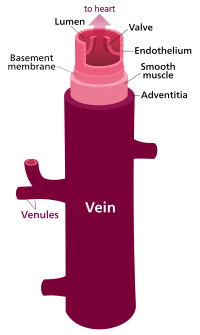
Photo from wikipedia
ObjectiveThe effects of hydroxyethyl starch (HES) on microcirculation, central venous oxygen saturation (ScvO2), and the central venous-to-arterial carbon dioxide gap (dCO2) are studied in a rabbit model of hemorrhagic shock… Click to show full abstract
ObjectiveThe effects of hydroxyethyl starch (HES) on microcirculation, central venous oxygen saturation (ScvO2), and the central venous-to-arterial carbon dioxide gap (dCO2) are studied in a rabbit model of hemorrhagic shock for elucidating the advantages and drawbacks of resuscitation with HES compared with crystalloids.MethodsAn ear chamber and sublingual mucosa were used to examine blood vessels by intravital microscopy. Hemorrhagic shock was induced by removing nearly half of the blood volume. Twenty-two rabbits received 20 mL of HES by intravenous infusion immediately after bloodletting. Additional HES was then administered intravenously to a total volume of 100 mL. The other 22 rabbits (control) were intravenously given 40 mL of normal saline solution (NSS), followed by additional NSS to a total volume of 200 mL, administered under the same conditions as HES.ResultsAfter the infusion, the vessel density and perfusion rate of the sublingual microcirculation recovered in the HES group. The arteriolar diameter, blood flow velocity, and blood flow rate of the ear microcirculation were maintained in this group, and microcirculatory failure did not develop. In the NSS group, however, all 5 of the aforementioned measured variables were significantly smaller than those in the HES group after the completion of infusion. The recovery of ScvO2 and dCO2 to the respective baseline values was significantly better in the HES group than in the NSS group.ConclusionIntravenous infusion of HES effectively maintains adequate tissue oxygenation and perfusion in hemorrhagic shock.
Journal Title: Journal of Anesthesia
Year Published: 2018
Link to full text (if available)
Share on Social Media: Sign Up to like & get
recommendations!